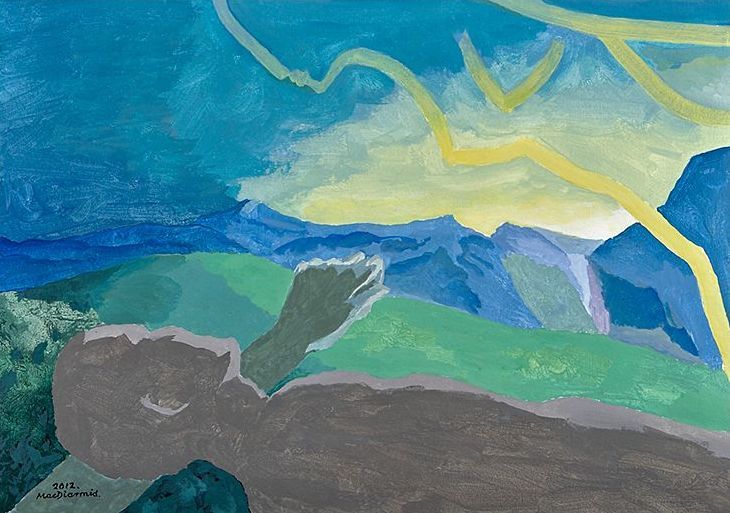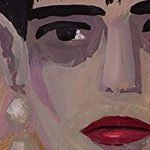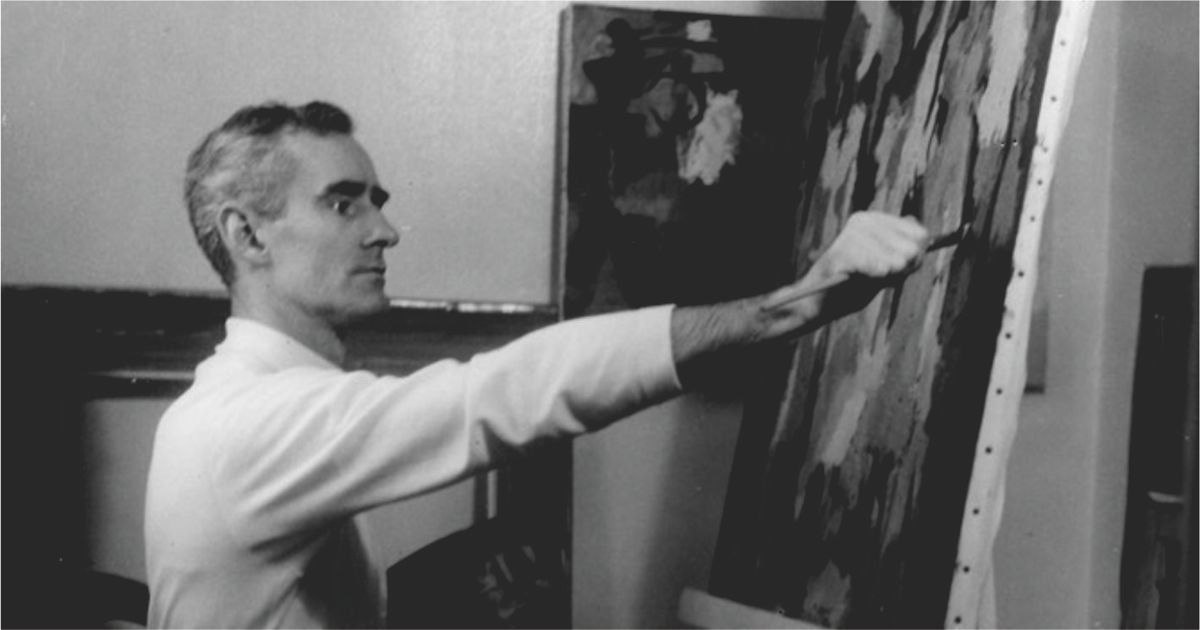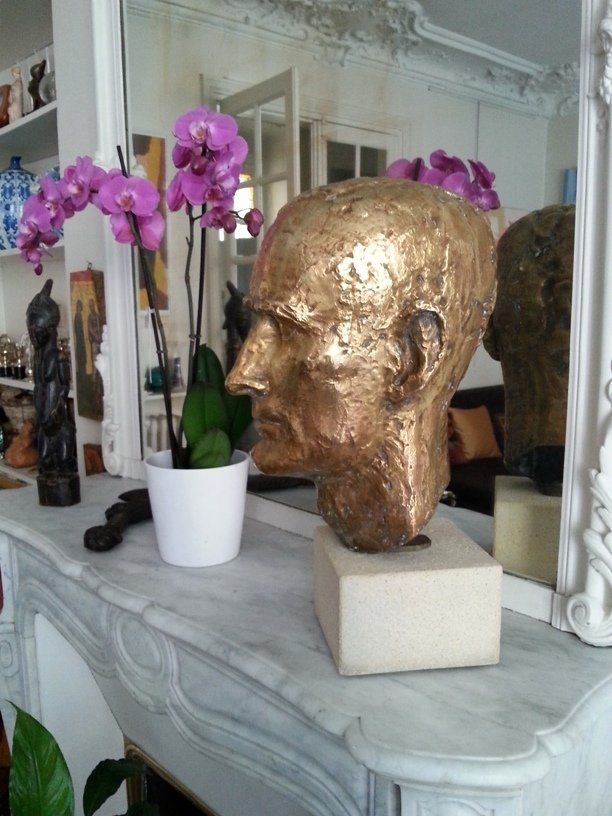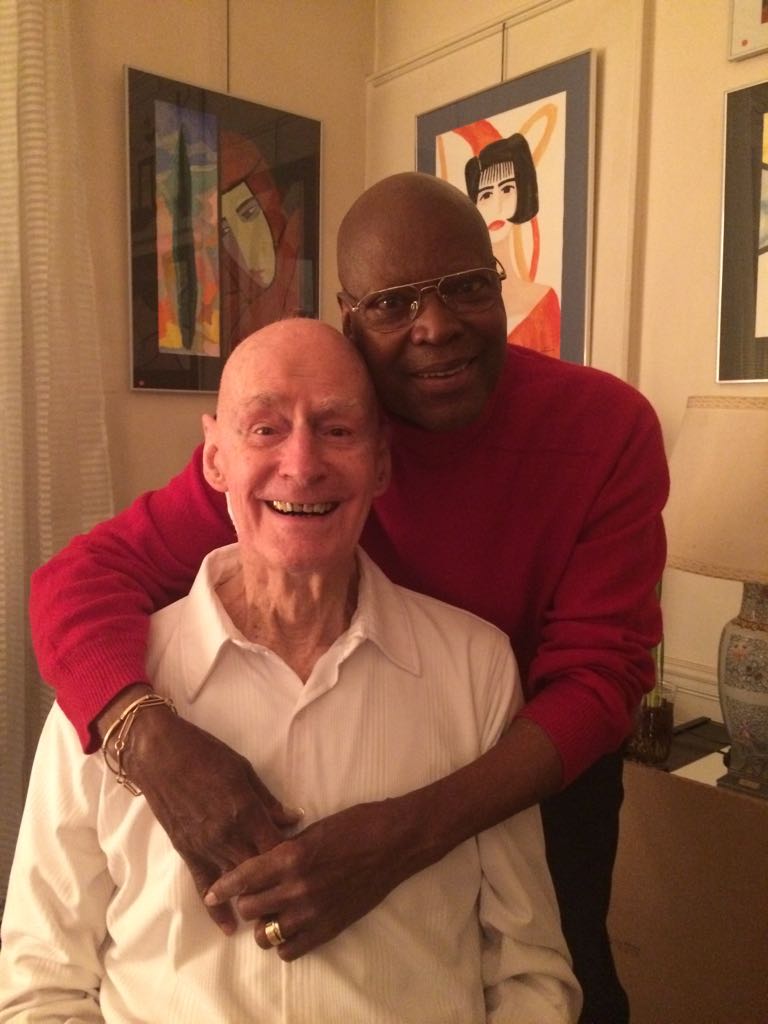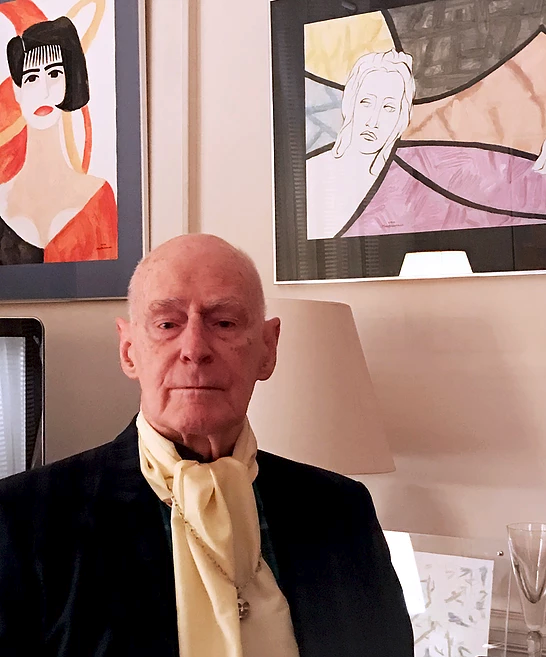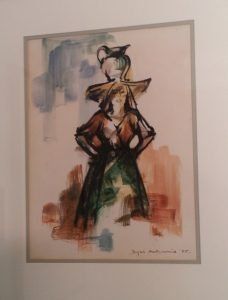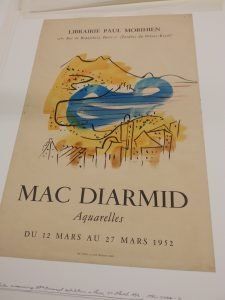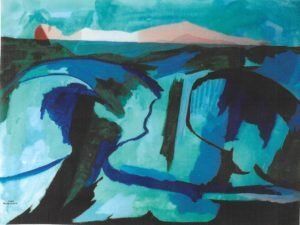The Nostalgia Paintings 1947
A bomb-ravaged city. Bone-chilling cold. Food rationing, coupon queues, shortages of everything. Dreary days, dark by 3pm. Thick yellow fogs seeping through cracks in the walls. No sunlight.
This was London 1947, post-World War II, Douglas MacDiarmid‘s first overseas experience. Sometimes the excitement of being away on the other side of the world gave way to homesickness and melancholy – a craving for warmth, clean air and sunshine. In this frame of mind, the young man cast his mind back to childhood memories, painting two little landscape coloured by feelings more mixed than ever.
Unusually, ‘Tiriraukawa, Papa Cliff Pool with Bathers’ and its companion ‘Recreation Ground’, were both made without any preliminary drawings, created from memory “with all heart and longing”. At the time Douglas was boarding with an older New Zealand expatriate, the notorious gay poet and writer D’Arcy Cresswell, in a cottage at St John’s Wood, London. He painted in his “gloomy room” with no windows except a skylight in the roof.
In post-blitz London all goods, painting materials included, were expensive, in short supply and of very mixed quality. That’s why Douglas painted on cardboard, hardboard etc in his early days…whatever he could find.
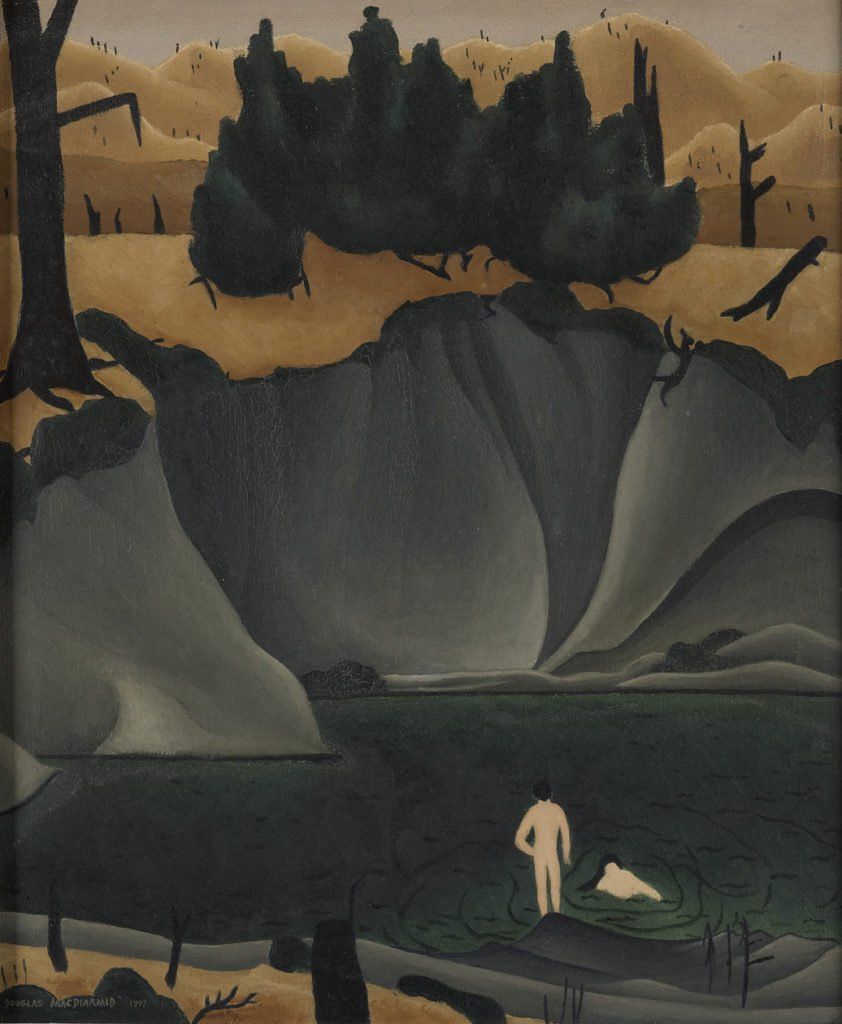
Originally called ‘Papa cliff and pool’, the location Tiriraukawa was added later to pinpoint the scene to a rural area 15km south-east of Taihape on the Mangapapa River, where Douglas stayed on a friend’s farm during school holidays.
In her 2002 art history MacDiarmid, Dr Nelly Finet describes the scene as a “a pool in a stream idyllic but for the haunting vestiges of burned out trees” – the area being in the fall-out zone of nearby active volcanoes that formed this broken, tussocky landscape. Douglas remembers having a riot of fun – riding over fallen logs at full gallop and sliding down a papa-clay cliff waterfall on an old wooden gate. The boy in the picture is “vaguely me” but he sees the painting more as a matter of vision than description.
“The very way one uses one’s eyes is conditioned by the skies of childhood” he told art writer Christopher Johnstone, when the painting was included in his 2008 book Landscape Paintings of New Zealand – representing the Rangitikei region, on Page 148. In 2015, the Papa Cliff Pool picture became the cover image of A Deepening Stream: A History of the New Zealand Literary Fund, by Elizabeth Caffin and Andrew Mason.
Papa Cliff’s twin, ‘Recreation Ground’ was inspired by the Taihape sports ground of Douglas’ childhood, a favourite playground.
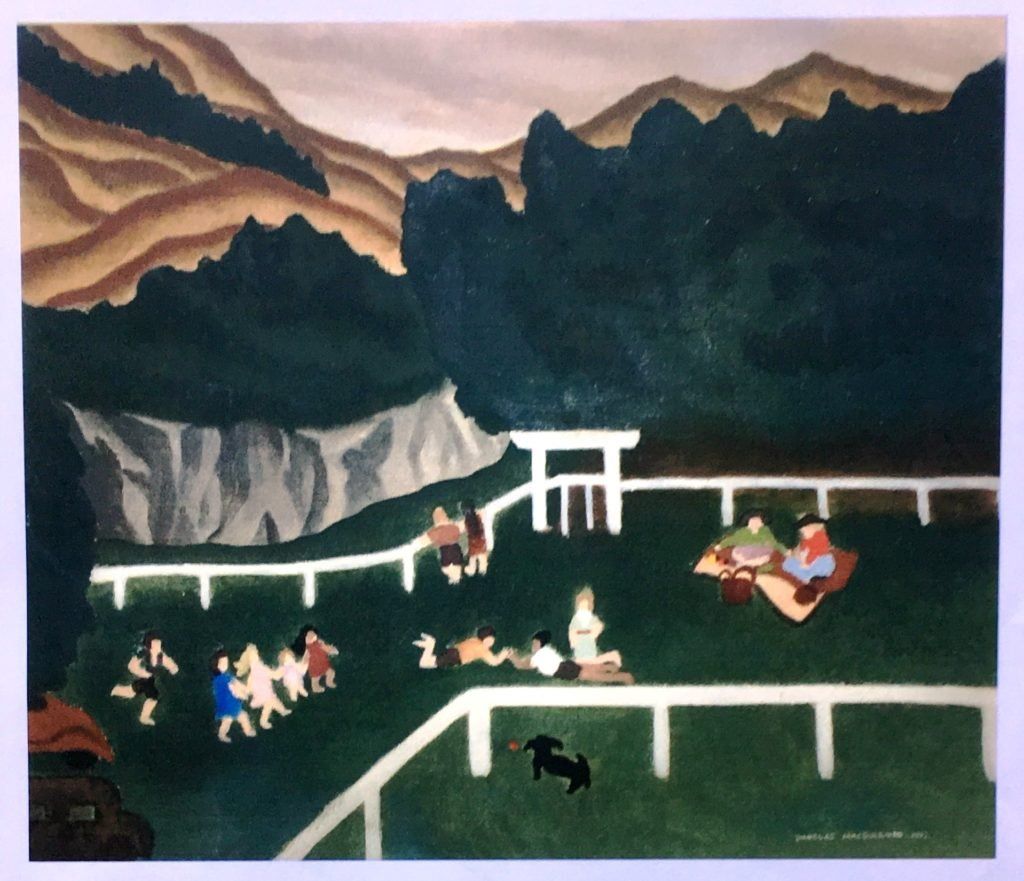
Another painting with a shifting title, the name changed when it was exhibited by the Christchurch art collective The Group in Wellington in 1950. Here, a group of children play on the edge of the bush, as Douglas recalls:
“Beside the school (which was right across the road from their house at 24 Huia Street) lay the town recreation grounds which were biggish. It was a rugby ground and it was a cricket ground and a place for agricultural and pastoral shows, and so on.
“We used to hive off into the dense bush. There was a gate that led off into a path winding through a fairly large reserve of native bush with endless tracks and hazards. It was really dense and so we used to have a marvellous time moving about in there, avoiding the tracks and playing games with whistles to signal our movements…you know, making adventures of our own.”
In Dr Nelly Finet’s art history MacDiarmid, the painting shows…“Apparently carefree children are hemmed in on all sides by oppressive bush”. Douglas’ New Zealand poet friend Louis Johnson was so moved by this scene he wrote poem about it, around 1950:
PLAYGROUND
(for a painting by Douglas MacDiarmid).
Even upon the deceptively green, the candid lawns
there is terror behind the children, in waiting hills,
and loneliness in the dark trees where the small
fancies shape gnomes or giants as fancy wills;
a hunger, waiting to pounce – something that is not all
in the picture’s focus; something suspended without that fawns
with dog-uncertainty certain to deceive. And children play –
simulate unawareness – but falter – and each suspects
the others know of the fear that’s beyond, but speak,
frightened, in still-shrill voices of pretence – detects
the awful outer silence, turns back, tiny and weak
within the scope of the frame – warm orbit of the known day.
Will be abstract or lost from the noise a moment; resume
More eagerly, play, to escape and be driven wilder on
From tormenting vagueness, knowing it can’t be seen
In the solid lawns or pond; and not believe in
Anymore, safety, for “nothing is what it seems” will be seen
more true, more terrible, in the dark part of the room.
Will day come like a flower and open silently? What hides
In the corner was what, out of sleep – haunting sleep –
was overheard – beyond touchpoint – realisation,
in the playground. Secret, will darkness weep,
and dreams gather and seep, and consternation
gather in pools and wait – wait there – outside.
While ‘Papa Cliff Pool with Bathers’ has been exhibited at Te Papa Tongarewa, and reproduced in books, ‘Recreation Ground’ 1947 was for decades the ‘missing’ companion, only known from a scratchy, little old black and white photograph Douglas carted around in a bundle of early painting images.
It was not until 2018 that the painting was located back in London, a much-loved piece of memorabilia in the collection of another expatriate New Zealander, an art lover who brought the painting on a visit home in 2006. As a child, his family used to stop off in Taihape on the way up to Taupo from Wellington, and visited the sports ground. Although he has never met Douglas, he is drawn to his paintings because they are “not only painted very well, but also resonate well with underlying feelings, memories and emotions.”
Finally, more than 70 years after his nostalgic episode, the painter again saw a colour photograph of this little gem. It was a welcome emotional boost, all the more so to know both paintings were well-loved and in good condition.
Douglas brought them back to New Zealand in 1949, with other recent paintings. Later in 1950, they appeared in his first solo commercial exhibition at Helen Hitchings Gallery in Wellington (Nos 11 and 12, £8 each). Helen, then Douglas’ lover, cherished them in her personal collection for decades until ‘Papa Cliff Pool with Bathers’ was sold when downsizing to the National Gallery, in its pre-Te Papa Tongarewa days.
Its twin surfaced in Helen’s estate clearance at a Dunbar Sloane art auction, Wellington in September 2002 (Lot No 150), snapped up by Ferner Galleries, for their catalogue: “Recreation Ground, at first glance a cheerful scene of children playing, has an ominous quality lurking in the background. Barren hills surround and entrench the children, a sheer grey cliff rises from the playground and a thick mass of dark trees seems to lean over and close in on the children below.”
There has been some confusion about the year these paintings were made. Douglas listed both as 1946 works in his 2002 art history, but Papa Cliff Pool is clearly dated 1947. He agrees the pictures were done at the same time, early that year before he moved to Paris, so to clear the matter up for once and for all, 1947 it is.
It’s been fascinating to observe the outpouring of happy childhood memories from people who grew up in Taihape, when shown photographs of these paintings…they remember the very spot on the river where children slid down the papa clay cliffs and swam, and the memorial gates of the recreation ground, with its dark bush beyond. One man was overjoyed to see his old playground, and recognised it immediately: “The painting depicts the back right of the ‘REC’ looking from the grandstand and shows the entrance to the bush walk. Just terrific, as I scored a lot of tries and won many races at the Rec! It has a special place in my past.”
A third painting, a watercolour from Helen’s 2002 estate sale (Lot 151), which also came to light in 2018, belongs in this same memory vein.
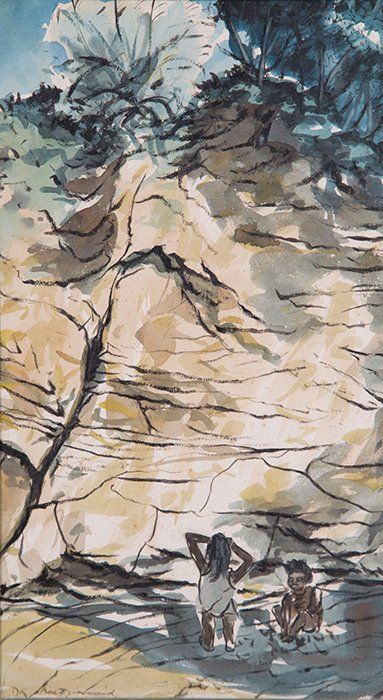
‘Children Playing at Papa Cliff’ sold at Dunbar Sloane’s New Zealand and International Fine Art Auction in August 2018, Lot 221. Again, it shows the distinctive grey volcanic paapa (clay) cliffs. These can be seen in Rangitikei Gorge near Taihape – a central North Island landmark familiar to motorists driving the main highway between Wellington and Auckland.
The subject matter and signature indicate this undated scene was created in London in 1947 at much the same time as those nostalgic little oil paintings of boyhood reminiscences.
To read more about Douglas MacDiarmid’s fascinating journey through life Buy your copy of Colours of a Life – the life and times of Douglas MacDiarmid by Anna Cahill (2018)

